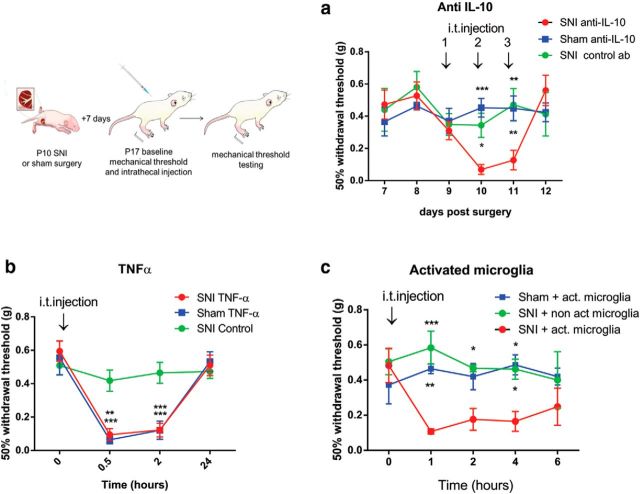Figure 7.
Blocking anti-inflammatory cytokines unmasks hypersensitivity in infants after nerve injury. Illustration shows that infant mice received daily intrathecal injections of anti-IL-10 (10 μg/4 μl or control antibody) 7 d after infant SNI for 3 d (days 7–9 after surgery). a, SNI mice treated with anti-IL-10 displayed a decrease in mechanical thresholds 1 h after the second and third injection, but recovered 1 d later. SNI mice treated with control antibody or sham mice treated with anti-IL-10 showed no change in mechanical thresholds (two-way ANOVA postinjection, treatment effect p = 0.006; F(2,15) = 7.379, n = 6 per treatment group; Bonferroni post hoc comparison, post-second injection:*p = 0.02, ***p = 0.001; post-third injection: **p = 0.0032 and 0.006). b, Intrathecal administration of TNF-α (20 ng) to infant mice 7 d after infant SNI caused a significant reduction in mechanical thresholds in sham and SNI-treated animals 3–180 min after injection, which recovered to baseline after 1 d (two-way ANOVA, treatment effect: p = 0.009, F(2,18) = 6.159), n = 7 per treatment group; Bonferroni post hoc comparison 0.5 h: **p = 0.0013, ***p = 0.0003; 3 h: ***p = 0.0006 and p = 0.0004). c, Infant mice (n = 5) received one 4 μl intrathecal injections of LPS-activated microglia or PBS nonactivated microglia control (1000 cells/ 10 μl) 7 d after infant SNI or sham surgery and mechanical thresholds were tested every hour. Only SNI-treated mice but not sham-treated mice displayed a decrease in mechanical thresholds to LPS-activated microglia (two-way ANOVA, treatment effect: p = 0.002, F(2,12) = 10.68), n = 5 per treatment group; Bonferroni post hoc comparison 1 h: ***p = 0.002, **p = 0.007; 2 h: *p = 0.038, 4 h: *p = 0.032 and 0.018). Thresholds of control animals show a nonsignificant decrease in baseline, arising presumably from repeated testing of animals treated (n = 6/treatment group). Graphs show mean ± SEM.

